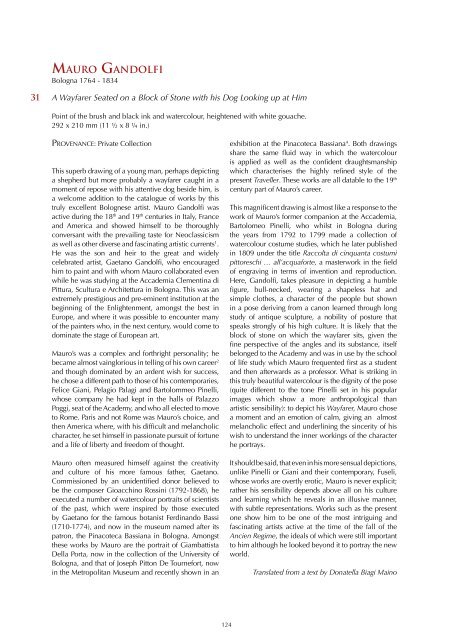You also want an ePaper? Increase the reach of your titles
YUMPU automatically turns print PDFs into web optimized ePapers that Google loves.
Mauro Gandolfi<br />
Bologna 1764 - 1834<br />
31<br />
A Wayfarer Seated on a Block of Stone with his Dog Looking up at Him<br />
Point of the brush and black ink and watercolour, heightened with white gouache.<br />
292 x 210 mm (11 ½ x 8 ¼ in.)<br />
Provenance: Private Collection<br />
This superb drawing of a young man, perhaps depicting<br />
a shepherd but more probably a wayfarer caught in a<br />
moment of repose with his attentive dog beside him, is<br />
a welcome addition to the catalogue of works by this<br />
truly excellent Bolognese artist. Mauro Gandolfi was<br />
active during the 18 th and 19 th centuries in Italy, France<br />
and America and showed himself to be thoroughly<br />
conversant with the prevailing taste for Neoclassicism<br />
as well as other diverse and fascinating artistic currents 1 .<br />
He was the son and heir to the great and widely<br />
celebrated artist, Gaetano Gandolfi, who encouraged<br />
him to paint and with whom Mauro collaborated even<br />
while he was studying at the Accademia Clementina di<br />
Pittura, Scultura e Architettura in Bologna. This was an<br />
extremely prestigious and pre-eminent institution at the<br />
beginning of the Enlightenment, amongst the best in<br />
Europe, and where it was possible to encounter many<br />
of the painters who, in the next century, would come to<br />
dominate the stage of European art.<br />
Mauro’s was a complex and forthright personality; he<br />
became almost vainglorious in telling of his own career 2<br />
and though dominated by an ardent wish for success,<br />
he chose a different path to those of his contemporaries,<br />
Felice Giani, Pelagio Palagi and Bartolommeo Pinelli,<br />
whose company he had kept in the halls of Palazzo<br />
Poggi, seat of the Academy, and who all elected to move<br />
to Rome. Paris and not Rome was Mauro’s choice, and<br />
then America where, with his difficult and melancholic<br />
character, he set himself in passionate pursuit of fortune<br />
and a life of liberty and freedom of thought.<br />
Mauro often measured himself against the creativity<br />
and culture of his more famous father, Gaetano.<br />
Commissioned by an unidentified donor believed to<br />
be the composer Gioacchino Rossini (1792-1868), he<br />
executed a number of watercolour portraits of scientists<br />
of the past, which were inspired by those executed<br />
by Gaetano for the famous botanist Ferdinando Bassi<br />
(1710-1774), and now in the museum named after its<br />
patron, the Pinacoteca Bassiana in Bologna. Amongst<br />
these works by Mauro are the portrait of Giambattista<br />
Della Porta, now in the collection of the University of<br />
Bologna, and that of Joseph Pitton De Tournefort, now<br />
in the Metropolitan Museum and recently shown in an<br />
exhibition at the Pinacoteca Bassiana 4 . Both drawings<br />
share the same fluid way in which the watercolour<br />
is applied as well as the confident draughtsmanship<br />
which characterises the highly refined style of the<br />
present Traveller. These works are all datable to the 19 th<br />
century part of Mauro’s career.<br />
This magnificent drawing is almost like a response to the<br />
work of Mauro’s former companion at the Accademia,<br />
Bartolomeo Pinelli, who whilst in Bologna during<br />
the years from 1792 to 1799 made a collection of<br />
watercolour costume studies, which he later published<br />
in 1809 under the title Raccolta di cinquanta costumi<br />
pittoreschi … all’acquaforte, a masterwork in the field<br />
of engraving in terms of invention and reproduction.<br />
Here, Gandolfi, takes pleasure in depicting a humble<br />
figure, bull-necked, wearing a shapeless hat and<br />
simple clothes, a character of the people but shown<br />
in a pose deriving from a canon learned through long<br />
study of antique sculpture, a nobility of posture that<br />
speaks strongly of his high culture. It is likely that the<br />
block of stone on which the wayfarer sits, given the<br />
fine perspective of the angles and its substance, itself<br />
belonged to the Academy and was in use by the school<br />
of life study which Mauro frequented first as a student<br />
and then afterwards as a professor. What is striking in<br />
this truly beautiful watercolour is the dignity of the pose<br />
(quite different to the tone Pinelli set in his popular<br />
images which show a more anthropological than<br />
artistic sensibility): to depict his Wayfarer, Mauro chose<br />
a moment and an emotion of calm, giving an almost<br />
melancholic effect and underlining the sincerity of his<br />
wish to understand the inner workings of the character<br />
he portrays.<br />
It should be said, that even in his more sensual depictions,<br />
unlike Pinelli or Giani and their contemporary, Fuseli,<br />
whose works are overtly erotic, Mauro is never explicit;<br />
rather his sensibility depends above all on his culture<br />
and learning which he reveals in an illusive manner,<br />
with subtle representations. Works such as the present<br />
one show him to be one of the most intriguing and<br />
fascinating artists active at the time of the fall of the<br />
Ancien Regime, the ideals of which were still important<br />
to him although he looked beyond it to portray the new<br />
world.<br />
Translated from a text by Donatella Biagi Maino<br />
124
















